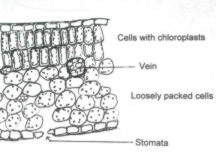
From the Ground Up
by Derek Burch
Leaves: Part A
The easiest-to-see parts of the plant, apart from the flowers, and probably the most variable in shape and form are the leaves. All share one thing, however, they are the place, in most plants, in which the energy of light is trapped and converted into simple sugars by the process called photosynthesis.
If you have been reading the earlier offerings in this series, which is meant to be an introduction to what is going on inside the plant, you will have had this idea thrown at you more than once already. Each part has its separate function that contributes to the plant as a whole, and the function of the leaves is to use the energy of light to power chemical reactions that form simple sugars from carbon dioxide and water. The process gives off oxygen as a waste product, which is a good thing for us in the animal kingdom.The chemical reactions are quite complicated, and take place in two stages, only one of which requires light. The actual sites at which they go on are green-colored structures called chloroplasts. These are located in cells of the leaf, typically in a few tightly packed layers close to the upper surface of the leaf. At this stage we need a diagram to which to point.
There may not be a leaf exactly like this in nature, but it will illustrate what I need to explain.
Let's stay with the closely packed cells for a moment. If the leaf is growing in very strong light, there may be more layers of cells than you would have in a shade-grown leaf (remember how the leaves that grew back on that ficus when it got used to the light in your living rooms, were larger and thinner than the ones that it lost when you brought it in from the nice bright nursery).
There are veins running all through these layers, carrying liquids in and out. In fact, no cell is more than a couple of cells away from the tiny end divisions of the veins. It has to be that way, doesn't it, for the transport system to work.
On the top and bottom surface of most leaves is a waterproof layer that keeps the leaf from drying up. But the cells need to be in touch with the outside air so that they can get the gases that they need and get rid of waste gases. And something else happens in the leaf which could not go on if there was a complete seal over it. That something else is the controlled loss of water, which sets up a water tension in the cells of the leaf that acts like a suction pump to pull the water up from the roots. This is the way in which the water and all the substances dissolved in it are able to travel all over the plant.
So, on the one hand, the leaves have to be protected from drying out, but on the other hand they have to allowed to dry in a very controlled manner so that the water can move around the plant. The drying happens in the loosely-packed cells in the underside of the leaf. The air spaces between these cells are in contact with the outside air through openings which can be opened or closed. When they are open, the drier outside air picks up water from the moist surfaces of these loosely packed cells and carries it away. The drier cells then draw water from wetter cells which they touch, and these in turn become under water tension. This transfer of tension eventually reaches a cell in the fine branches of the veinlets, and is passed on to other cells, and the effect is to suck water up from the roots. At that end of the plant, the tension draws water in from the soil, and the pump is in operation.
The leaves are thus at the heart of two very important activities of the plant: making the simple sugars using the energy from light, and causing the suction to develop in the conducting tissue that brings in liquid from the soil and transports it around the plant.
On to some other things about leaves
Back to the Table of Contents
